Today is the third tutorial in the Back to Basics Cold Process Series. The first two projects were designed to give you a “feel” for soaping, and did not feature color or any complex design elements. Now, we are ready to work with color, thick trace and gel phase! The Back to Basics Soapmaking Kit includes all the soaping ingredients you need to create all four recipes in this series, including the 10″ Silicone Loaf Mold. Now, let’s get soaping!
Basic layers are a fantastic design option for the beginner soaper. To make sure layers don’t blend together, the bottom layers of soap need to be thicker than the top layers. This Layered Lavender Cold Process Soap works with thick trace to ensure the layers stay separate. Thick trace soap has a texture similar to pudding, and holds its shape. To help give the soap its thick texture, this project uses Lavender & Cedar Fragrance Oil, which accelerates very slightly. To learn more about trace, check out the All About the Trace blog post.
In addition, this project uses LabColors to give the layers a purple ombre effect. LabColors are highly concentrated liquid dyes. In order to be used in water based projects, they first must be diluted in distilled water. Click here to learn more about LabColors, and how to dilute them. LabColors become more vibrant when the soap goes through gel phase. Gel phase refers to the part of the saponification process where the soap gets warm and gelatinous. Gelled soap looks slightly more transluscent and shiny than non-gelled soap. Click here to read more about gel phase, and see how gel phase affects LabColors.
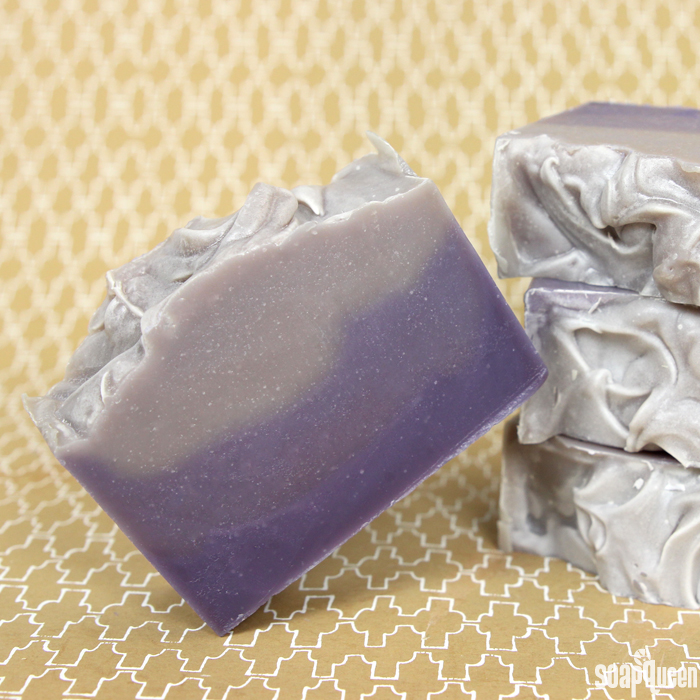
Layered Lavender Cold Process Recipe (superfat 5%)
10″ Silicone Loaf Mold
5.1 oz Canola Oil (15%)
8.5 oz. Coconut Oil (25%)
10.2 oz. Olive Oil (30%)
10.2 oz. Palm Oil (30%)
4.8 oz. Sodium Hydroxide Lye
11.2 oz. Distilled Water
3 oz. Lavender & Cedar Fragrance Oil
Diluted Periwinkle High pH LabColor (small)
This tutorial is the third in the Back to Basics Cold Process Series. This series of tutorials includes four cold process recipes that are perfect for beginning soapers. The Back to Basics Soapmaking Kit includes all the soaping ingredients you need to create all four recipes, including the 10″ Silicone Mold. The only ingredient you need to buy separately is lye, and any tools you may need. A great way to receive the basic soaping tools is with the Beginner’s Soaping Tool Kit, or click the “Buy it Now” button for the tools necessary for this project, lye and kit to your cart to your cart separately.

Click here to add everything you need for this project to your Bramble Berry shopping cart!
If you’ve never made Cold Process soap before, stop here! I highly recommend checking out our FREE four part SoapQueen.tv series on Cold Process Soapmaking, especially the episode on lye safety. And if you’d rather do some reading, Bramble Berry carries a wide range of books on the topic, including my newest book, Soap Crafting. You can also checkout the digital downloads for that instant gratification factor. I also recommend reviewing the first blog post in this series, which is all about how to handle lye safely.
FRAGRANCE PREP: In a glass, fragrance safe container, measure 3 oz. Lavender & Cedar Fragrance Oil. Set aside.
COLOR PREP: LabColors are super concentrated liquid dyes. In order to use them in cold process soap and other projects, they first need to be diluted. If you have never diluted Lab Colors before, check out this blog post. For this project, the small Periwinkle High pH LabColor needs to be diluted in 4 oz. distilled water. Don’t forget to add a preservative!
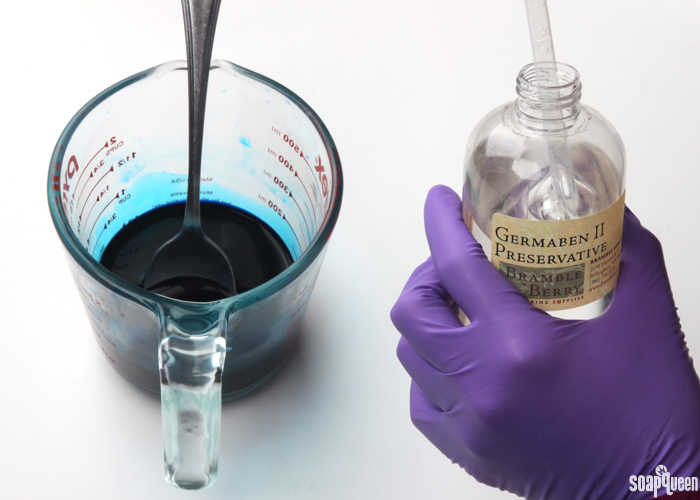 Set Up Your Area: Before soaping, it’s helpful to have your soaping area prepared before you start. While soaping, you don’t want to be running around looking for a spatula or whisk! This recipe requires a few whisks, and separate containers for the three colors. You will need your fully lined mold, prepared lye water, pre-mixed oils, stick blender, and a spatula. Check out the Soapy Session Preparation and Setup Guide for tips.
Set Up Your Area: Before soaping, it’s helpful to have your soaping area prepared before you start. While soaping, you don’t want to be running around looking for a spatula or whisk! This recipe requires a few whisks, and separate containers for the three colors. You will need your fully lined mold, prepared lye water, pre-mixed oils, stick blender, and a spatula. Check out the Soapy Session Preparation and Setup Guide for tips.
SAFETY FIRST: Suit up for safe handling practices! That means goggles, gloves and long sleeves. Make sure kids, pets, and other distractions and tripping hazards are out of the house or don’t have access to your soaping space. Always soap in a well-ventilated area.
ONE: Slowly and carefully add the lye to the water and gently stir until the lye has fully dissolved and the liquid is clear. Set aside to cool.
TWO: Combine the coconut oil, olive oil, palm oil and canola oils (remember to fully melt then mix your entire container of palm oil before portioning). Once the lye water and the oils have cooled to 130 degrees or below (and are ideally within 10 degrees of each other). If you’d like a harder bar of soap that releases faster from the mold, you can add sodium lactate to the cooled lye water. Use 1 teaspoon of sodium lactate per pound of oils in the recipe. For this recipe, add about 2 tsp. sodium lactate.
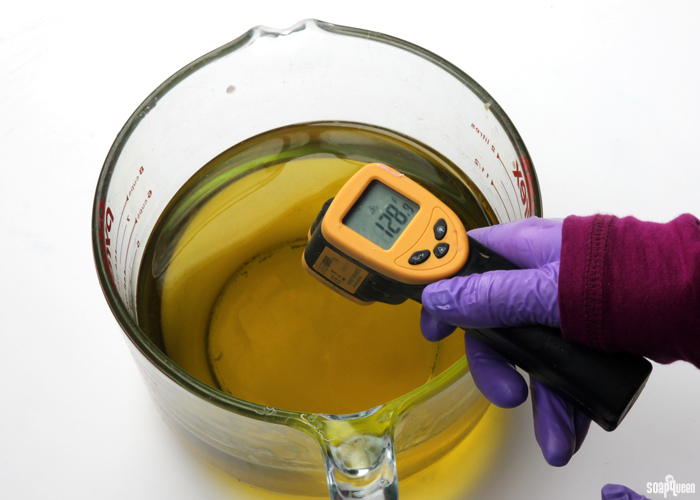 THREE: Place your stick blender into the oils. Gently tap the blender on the bottom of the bowl several times to release any bubbles that got trapped by the stick blender head. This is called, “burping the stick blender.”
THREE: Place your stick blender into the oils. Gently tap the blender on the bottom of the bowl several times to release any bubbles that got trapped by the stick blender head. This is called, “burping the stick blender.”
FOUR: Once bubbles no longer rise to the surface of the oils, gently pour the cooled lye water down the shaft of the stick blender and into the oils.
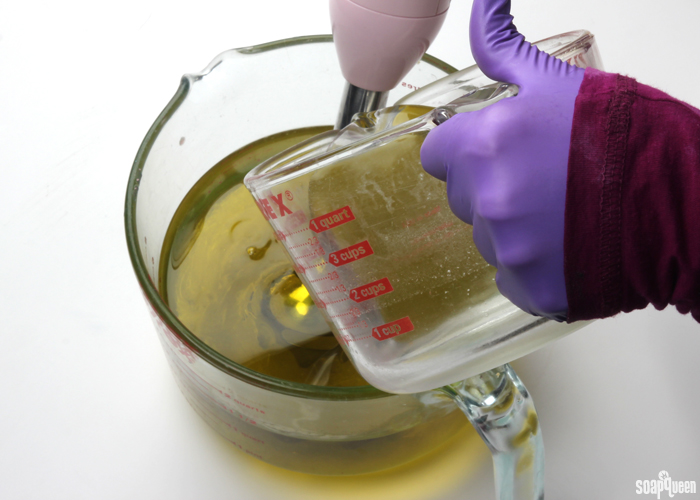 FIVE: Turn on the stick blender and pulse several times. You will immediately see the lye and oils begin to come together, and begin to create a creamy yellow color. Alternate between using the stick blender to stir the mixture, and pulsing the stick blender. After about 20-30 seconds, test for trace.
FIVE: Turn on the stick blender and pulse several times. You will immediately see the lye and oils begin to come together, and begin to create a creamy yellow color. Alternate between using the stick blender to stir the mixture, and pulsing the stick blender. After about 20-30 seconds, test for trace.
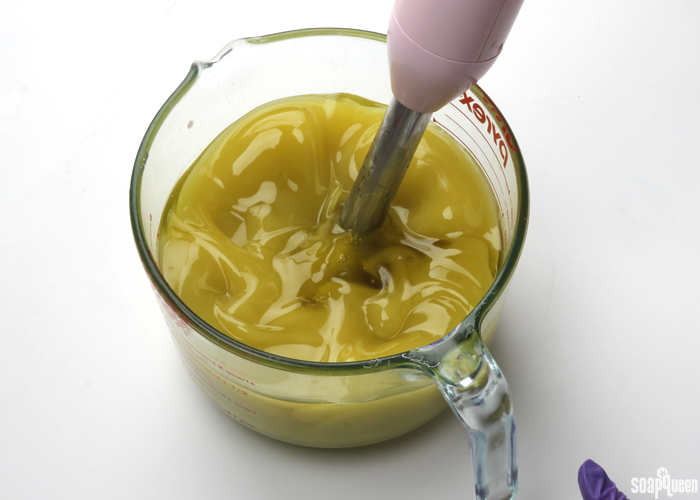 Below, you can see that when the stick blender is pulled out of the mixture, the drips or trailings of soap do not suspend on the top. This soap is still a very thin trace. Later, this soap will be stick blended further for a thicker texture. To help mix in the colorant and fragrance easier, stop once you have reached this point.
Below, you can see that when the stick blender is pulled out of the mixture, the drips or trailings of soap do not suspend on the top. This soap is still a very thin trace. Later, this soap will be stick blended further for a thicker texture. To help mix in the colorant and fragrance easier, stop once you have reached this point.
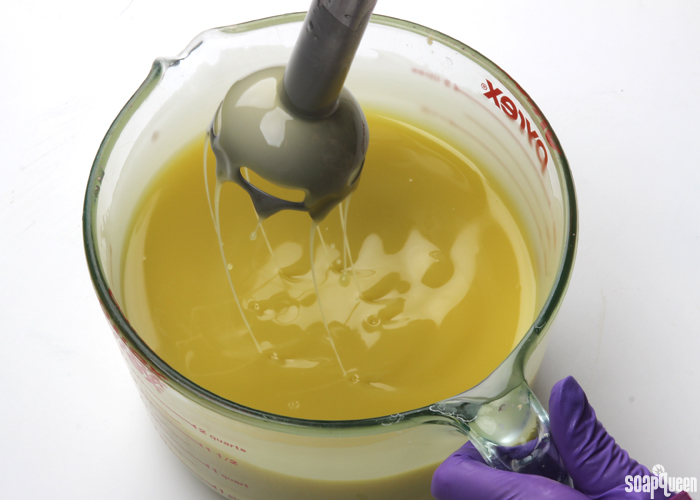 SIX: Pour in the 3 oz. of Lavender & Cedar Fragrance Oil, and use a whisk to thoroughly stir in. Once the mixture is completely mixed into the soap, split the soap into three equal containers (it’s okay to eyeball it!) Each container will hold about 2 cups of soap.
SIX: Pour in the 3 oz. of Lavender & Cedar Fragrance Oil, and use a whisk to thoroughly stir in. Once the mixture is completely mixed into the soap, split the soap into three equal containers (it’s okay to eyeball it!) Each container will hold about 2 cups of soap.
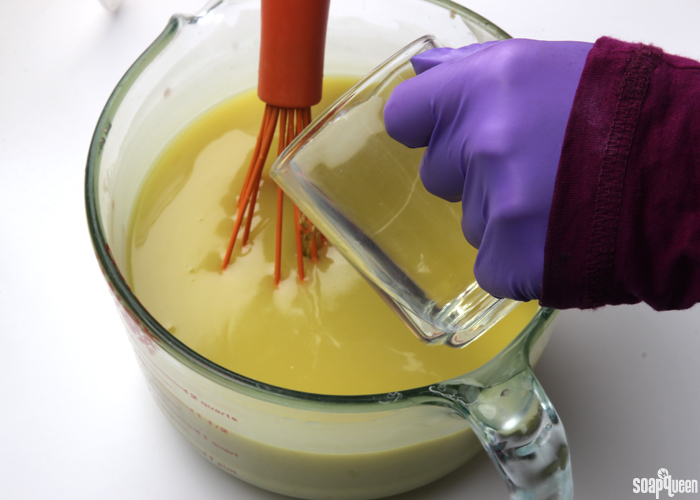
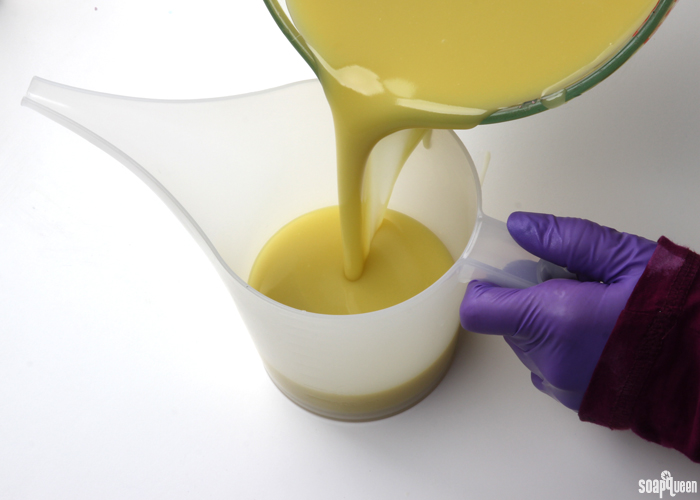 SEVEN: Add the diluted Periwinkle High pH LabColor to each container in the amounts listed below. Use a whisk to mix in the LabColor. You will notice the LabColor will turn the soap a shade of blue/green, and soon morph into a gray color. Don’t worry! Once the soap fully saponifies and goes through gel phase, the grey will transform into purple. Check out this blog post to learn more about LabColors and gel phase.
SEVEN: Add the diluted Periwinkle High pH LabColor to each container in the amounts listed below. Use a whisk to mix in the LabColor. You will notice the LabColor will turn the soap a shade of blue/green, and soon morph into a gray color. Don’t worry! Once the soap fully saponifies and goes through gel phase, the grey will transform into purple. Check out this blog post to learn more about LabColors and gel phase.
- Container A (dark purple): 7 mL diluted Periwinkle LabColor
- Container B: (medium purple): 5 mL Periwinkle diluted LabColor
- Container C (light purple) 3 mL diluted Periwinkle LabColor
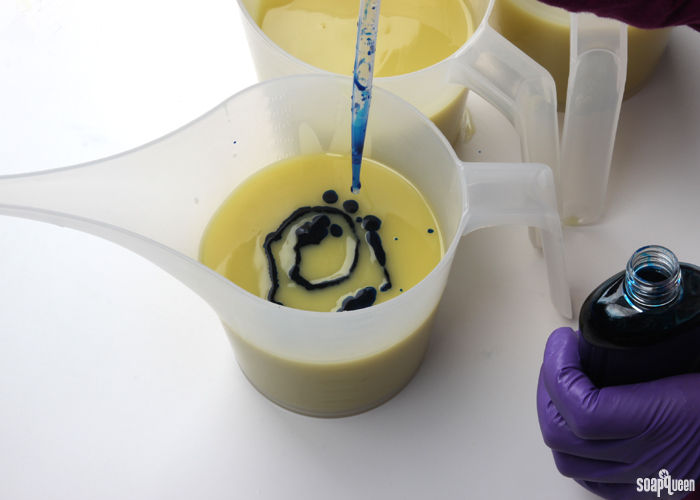
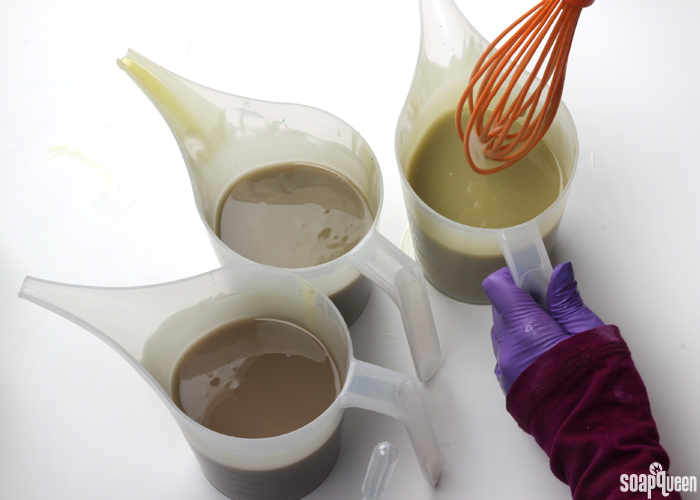 NINE: Check the trace of your soap. In order to make the layers in this project, the soap needs to be a medium to thick trace. If your soap is still fairly liquid, stick blend each container for several seconds to thicken. You want the soap be the texture of the soap to be a thick pudding.
NINE: Check the trace of your soap. In order to make the layers in this project, the soap needs to be a medium to thick trace. If your soap is still fairly liquid, stick blend each container for several seconds to thicken. You want the soap be the texture of the soap to be a thick pudding.
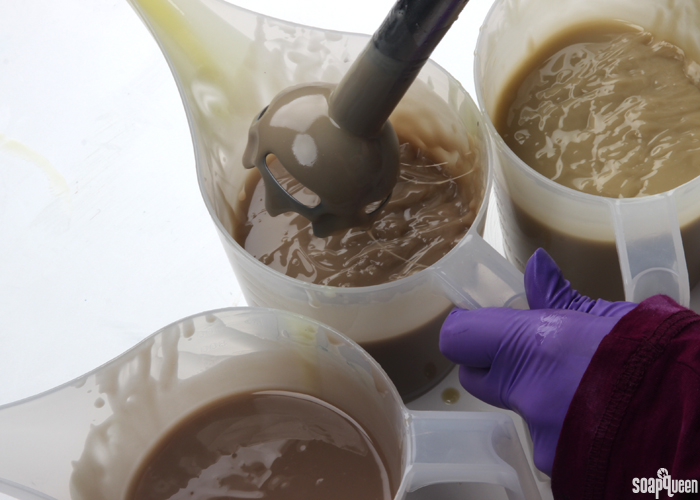 TEN: Pour the entire container of the darkest soap into the mold, and tap it down on the counter to eliminate air bubbles. Use a spoon to smooth the texture and make peaks.
TEN: Pour the entire container of the darkest soap into the mold, and tap it down on the counter to eliminate air bubbles. Use a spoon to smooth the texture and make peaks.
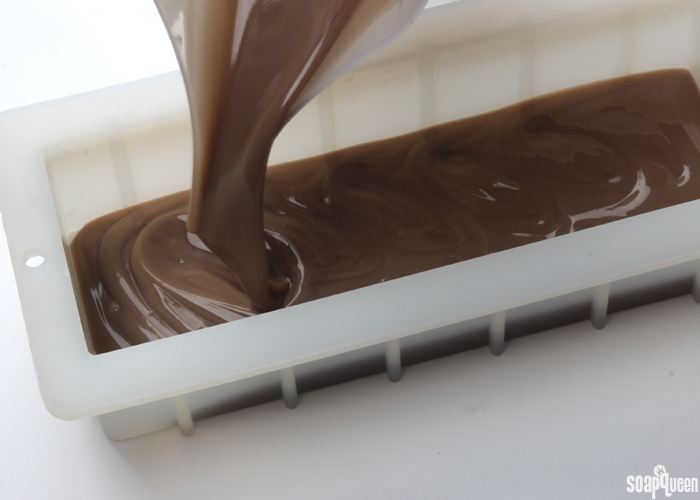
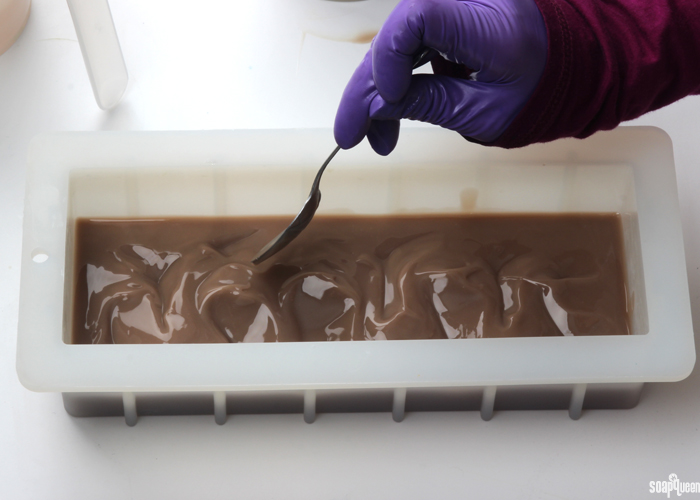 ELEVEN: Use a spoon to gently place the medium purple (gray) color onto the bottom. Use a spoon to spread the soap throughout the mold and create subtle texture within the layer.
ELEVEN: Use a spoon to gently place the medium purple (gray) color onto the bottom. Use a spoon to spread the soap throughout the mold and create subtle texture within the layer.
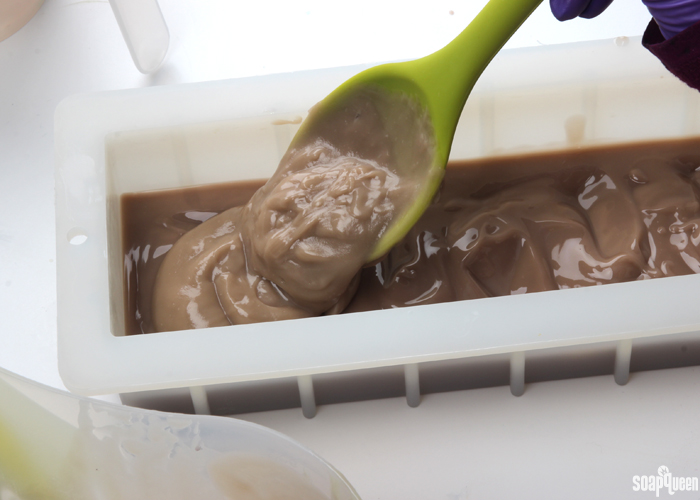
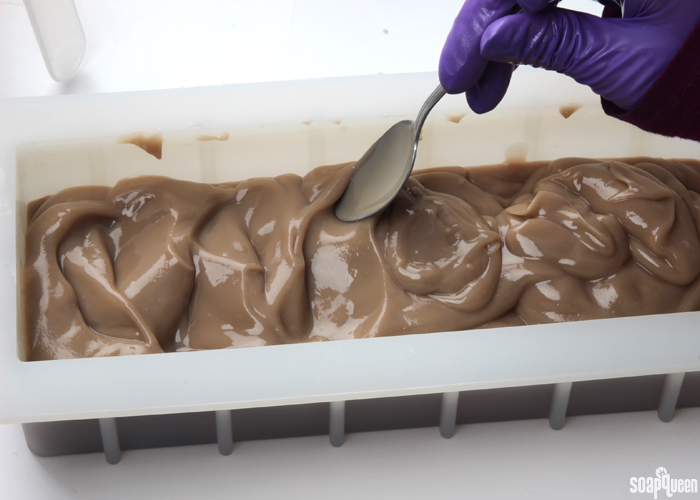 THIRTEEN: Finally, spoon the lightest color of soap into the mold. Use a spoon to spread the mixture evenly throughout the mold, and to create texture. There is no right or wrong way to create a textured top, just have fun with it!
THIRTEEN: Finally, spoon the lightest color of soap into the mold. Use a spoon to spread the mixture evenly throughout the mold, and to create texture. There is no right or wrong way to create a textured top, just have fun with it!
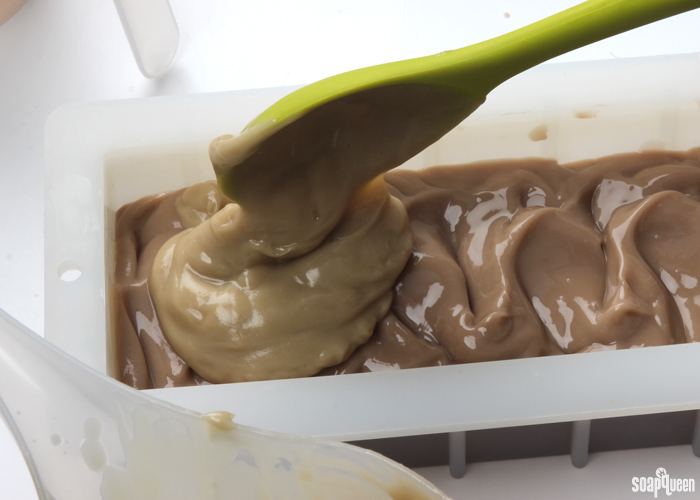
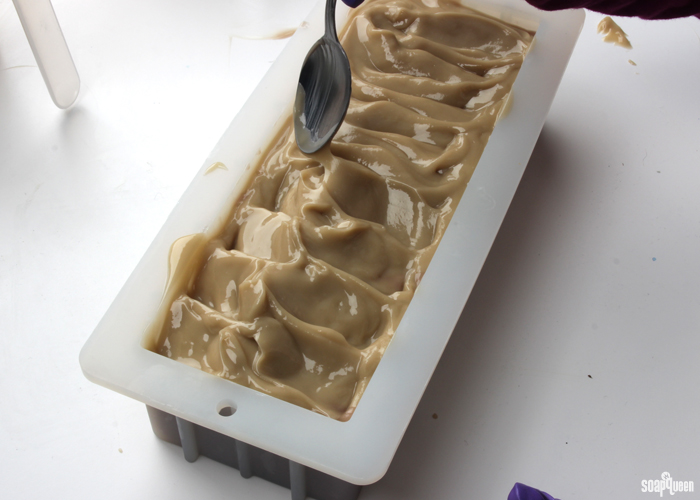 FOURTEEN: Once you’re happy with how the top looks, spray the top with 99% isopropyl alcohol to avoid soda ash.
FOURTEEN: Once you’re happy with how the top looks, spray the top with 99% isopropyl alcohol to avoid soda ash.
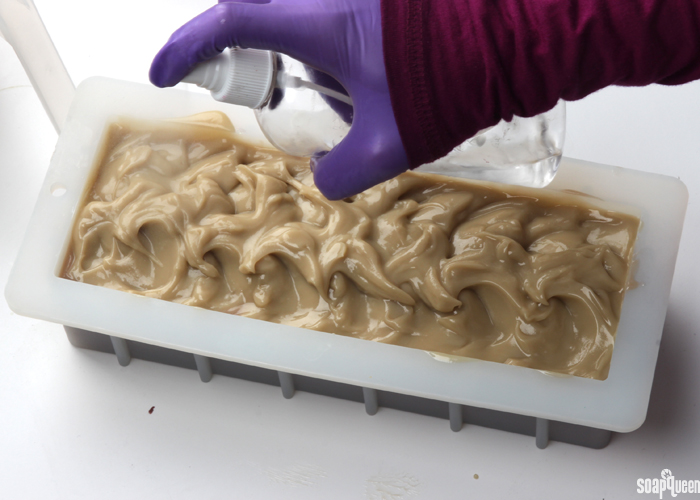 FIFTEEN: This soap needs to go through gel phase in order to make the colors really pop. The difference between the wet soap (above) and the final soap is extraordinary – but it does depend on the soap going through gel phase (not sure what gel phase is? Click here to read all about it). Depending on your climate, you may need to help the soap heat up with a heating pad. Turn the heating pad on medium/high, and place the soap on top. Then, cover the soap. To avoid mashing the textured top, we created a cover out of cardboard, shaped like a tent. Place the tented cardboard on top of the mold, and cover with a blanket to insulate. After about 20-30 minutes, turn off the heating pad, but leave the blanket and cardboard on top. Allow to remain under the cardboard and blanket for 24 hours. Allow the soap to remain in the mold for 3-4 days. Remove from mold, cut into bars and allow to cure for 4-6 weeks. Enjoy!
FIFTEEN: This soap needs to go through gel phase in order to make the colors really pop. The difference between the wet soap (above) and the final soap is extraordinary – but it does depend on the soap going through gel phase (not sure what gel phase is? Click here to read all about it). Depending on your climate, you may need to help the soap heat up with a heating pad. Turn the heating pad on medium/high, and place the soap on top. Then, cover the soap. To avoid mashing the textured top, we created a cover out of cardboard, shaped like a tent. Place the tented cardboard on top of the mold, and cover with a blanket to insulate. After about 20-30 minutes, turn off the heating pad, but leave the blanket and cardboard on top. Allow to remain under the cardboard and blanket for 24 hours. Allow the soap to remain in the mold for 3-4 days. Remove from mold, cut into bars and allow to cure for 4-6 weeks. Enjoy!
Have you worked with layers and LabColors to create an ombre effect? If you like the effect, check out the Striped Berry Champagne Cold Process tutorial!
- 5.1 oz Canola Oil (15%)
- 8.5 oz. Coconut Oil (25%)
- 10.2 oz. Olive Oil (30%)
- 10.2 oz. Palm Oil (30%)
- 4.8 oz. Sodium Hydroxide Lye
- 11.2 oz. Distilled Water
- 3 oz. Lavender & Cedar Fragrance Oil
- Diluted Periwinkle High pH LabColor (small)
- Slowly and carefully add the lye to the water and gently stir until the lye has fully dissolved and the liquid is clear. Set aside to cool.
- Combine the coconut oil, olive oil, palm oil and canola oils (remember to fully melt then mix your entire container of palm oil before portioning). Once the lye water and the oils have cooled to 130 degrees or below (and are ideally within 10 degrees of each other), add the lye water to the oils and stick blend until you reach a light trace. If you’d like a harder bar of soap that releases faster from the mold, you can add sodium lactate to the cooled lye water. Use 1 teaspoon of sodium lactate per pound of oils in the recipe. For this recipe, add about 2 tsp. sodium lactate.
- Place your stick blender into the oils. Gently tap the blender on the bottom of the bowl several times to release any bubbles that got trapped by the stick blender head. This is called, “burping the stick blender.”
- Once bubbles no longer rise to the surface of the oils, gentle pour the cooled lye water down the shaft of the stick blender and into the oils.
- Turn on the stick blender and pulse several times. You will immediately see the lye and oils begin to come together, and begin to create a creamy yellow color. Alternate between using the stick blender to stir the mixture, and pulsing the stick blender. After about 20-30 seconds, test for trace. Below, you can see that when the stick blender is pulled out of the mixture, the drips or trailings of soap do not suspend on the top. This soap is still a very thin trace. Later, this soap will be stick blended further for a thicker texture. But to help mix in the colorant and fragrance easier, stop once you have reached this point.
- Pour in the 3 oz. of Lavender & Cedar Fragrance Oil, and use a whisk to thoroughly stir in. Once the mixture is completely mixed into the soap, split the soap into three equal containers (it’s okay to eyeball it!) Each container will hold about 2 cups of soap.
- Add the diluted Periwinkle High pH LabColor to each container in the amounts listed below. Use a whisk to mix in the LabColor. You will notice the LabColor will turn the soap a shade of blue/green, and soon morph into a gray color. Don’t worry! Once the soap fully saponifies and goes through gel phase, the grey will transform into purple. Check out this blog post to learn more about LabColors and gel phase.
Container A (dark purple): 7 mL diluted LabColor
Container B: (medium purple): 5 mL diluted LabColor
Container C (light purple) 3 mL diluted LabColor - Check the trace of your soap. In order to make the layers in this project, the soap needs to be a medium to thick trace. If your soap is still fairly liquid, stick blend each container for several seconds to thicken. You want the soap be the texture of the soap to be a thick pudding.
- Pour the entire container of the darkest soap into the mold, and tap it down on the counter to eliminate air bubbles. Use a spoon to smooth the texture and make peaks.
- Use a spoon to gently place the medium purple (gray) color onto the bottom. Use a spoon to spread the soap throughout the mold and create subtle texture within the layer.
- Finally, spoon the lightest color of soap into the mold. Use a spoon to spread the mixture evenly throughout the mold, and to create texture. There is no right or wrong way to create a textured top, just have fun with it!
- Once you’re happy with how the top looks, spray the top with 99% isopropyl alcohol to avoid soda ash.
- This soap needs to go through gel phase in order to make the colors really pop! Depending on your climate, you may need to help the soap heat up with a heating pad. Turn the heating pad on medium/high, and place the soap on top. Then, cover the soap. To avoid mashing the textured top, we created a cover out of cardboard, shaped like a tent. Place the tented cardboard on top of the mold, and cover with a blanket to insulate. After about 20-30 minutes, turn off the heating pad, but leave the blanket and cardboard on top. Allow to remain under the cardboard and blanket for 24 hours. Allow the soap to remain in the mold for 3-4 days. Remove from mold, cut into bars and allow to cure for 4-6 weeks. Enjoy!
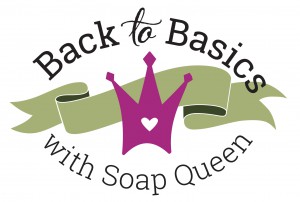
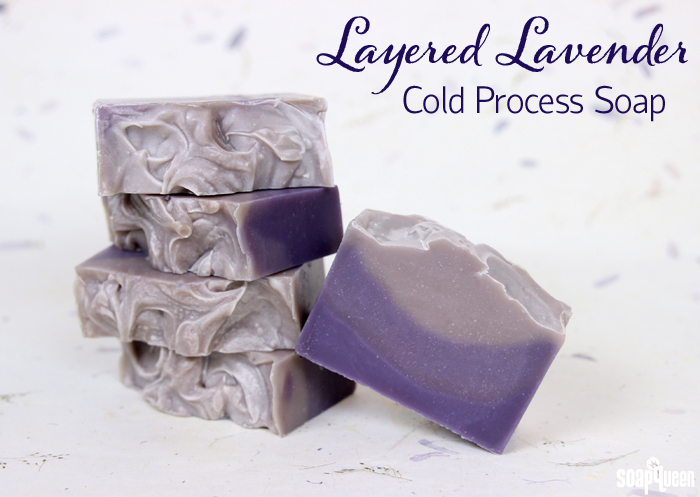
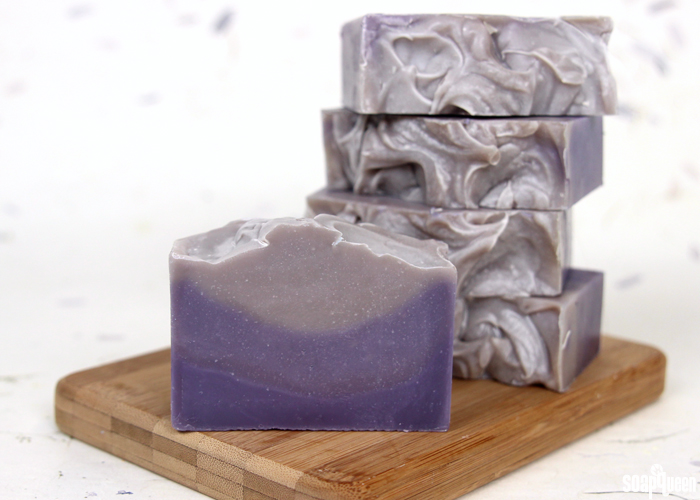
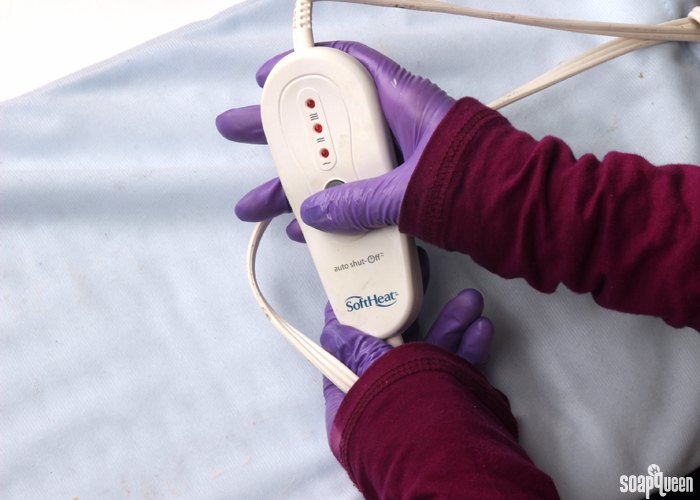
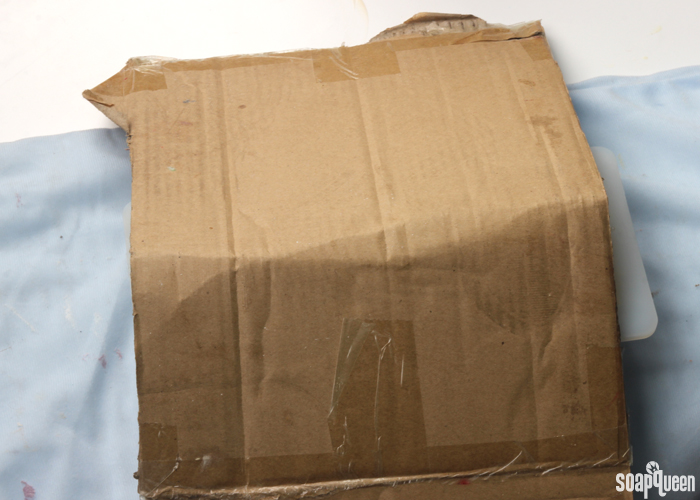
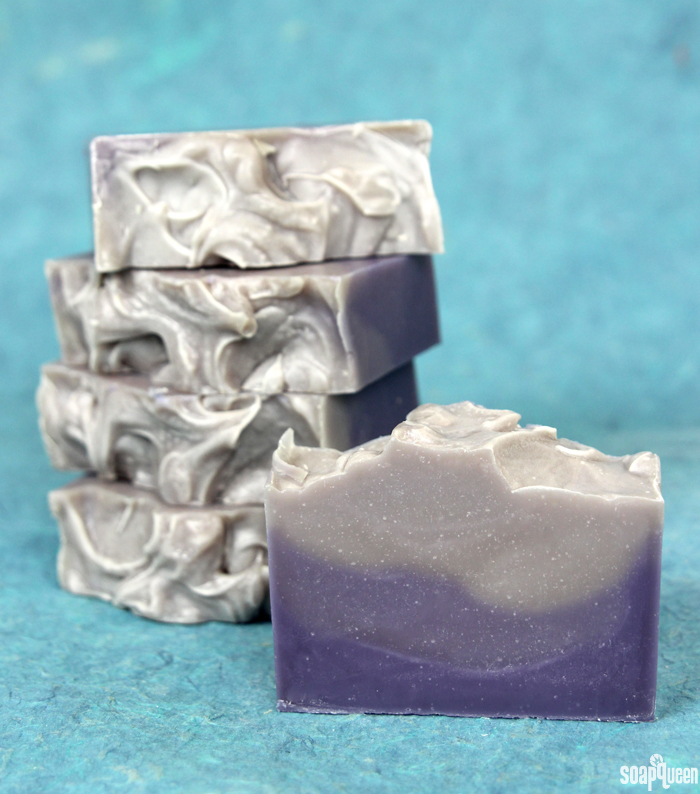

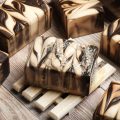
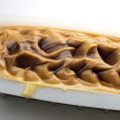
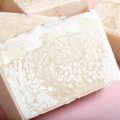
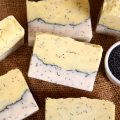
I would like to make this soap, but in blue. What labcolor would you suggest and what scent? Thanks!!
BlueMix LabColor is a great option: https://www.brambleberry.com/Blue-Mix-LabColor-P3011.aspx
It is used the same way as the Periwinkle – it needs to be diluted and then you can add the color at trace. Learn more about diluting LabColors here: http://www.soapqueen.com/bath-and-body-tutorials/tips-and-tricks/diluting-bramble-berry-labcolors/
As for “blue” scents, we have some fun options. Crisp Cotton is a fresh scent with notes of orange, violet, and thyme: https://www.brambleberry.com/Crisp-Cotton-Fragrance-Oil-P6192.aspx
Neroli and Shea is another option, it has notes of citrus and amber for an overall clean scent: https://www.brambleberry.com/Neroli-Shea-Blossom-Fragrance-Oil-P5864.aspx
-Kelsey with Bramble Berry
I am not able to find Lavender & Cedar Fragrance Oil in India. Could you suggest me a substitute for that? I have Lavender Fragrance Oil though.
Any skin-safe fragrance will work. As long as the lavender fragrance oil you have is approved for use in soap and cosmetics, it will work just fine. You can use our Fragrance Calculator to find out how much to add to this recipe: https://www.brambleberry.com/Pages/Fragrance-Calculator.aspx
-Kelsey with Bramble Berry
Brand new to soap making. I have started with your Back to Basics series. I have a question about the Labcolors…how do you measure the colorant in ml? Do you use a syringe?
We like to use droppers! They have mL markings on the side that make it easy to measure as you go. You can use a syringe with markings as well. 🙂
Droppers: https://www.brambleberry.com/Droppers-With-Suction-Bulb-P3802.aspx
-Kelsey with Bramble Berry
Thanks! The dropper came with my order, but I couldn’t read the markings on it. I ended up using 3 droppers, 2 droppers, and 1 dropper of the Periwinkle (diluted) for the 3 layers. I can upload a picture of my soap to your Facebook page.
This was only me second ever batch of soap, so I think I did really well. I didn’t push the thick soap batter into the corners on the 2nd and 3rd layers, so the end pieces in particular have a couple of gaps. Plus I didn’t have the alcohol. I finally found a small spray bottle and filled it with my 70% alcohol; I sprayed the tops after the fact, after I could see soda ash on the soap…and it gave the soap a really shiny surface and took care of the ash (I think!).
Not sure that I’m wild about the mounded top of this soap…I may play with other techniques instead on future batches.
My final concern/comment: I used the fragrance oil suggested, but I’m really a purist and am not sure about the health consequences of that choice. The MSDS sheet talks about not allowing it to get into drainage ditches, water supplies, lakes, ponds, streams, etc…since no actual ingredients are listed, I’m not sure about the wisdom of using soap (which is going to go into the waste treatment plant, which eventually ends up in lakes, streams, and the ocean) that contains these fragrance oils? Can you please shed some light on how saponification may or may not change the chemical structure of oils, whether fragrance or essential oils, to make them safer (or in the case of essential oils, to nullify the beneficial qualities)?
So glad your soap turned out well Marcie!
The MSDS is referring to undiluted fragrance oils going down the drain. You definitely don’t want to pour undiluted fragrance oils down the drain – the same goes for essential oils, cooking oil, etc. However, in the soap, it is highly diluted. So, any going down your drain will be a very small amount. The same goes for shampoo, conditioner, scrubs, etc. If you like, you can use essential oils! You can also leave the fragrance uncolored and unscented if you’d like a more natural bar. 🙂
Learn more about what fragrances are made of and how they work in soap here: https://www.youtube.com/watch?v=fHvuWaClMz0&t=1s
Essential oils: https://www.brambleberry.com/Essential-Oils-C157.aspx
Find out how much to add with our Fragrance Calculator: https://www.brambleberry.com/Pages/Fragrance-Calculator.aspx
-Kelsey with Bramble Berry
I want to use the 5lb wooden loaf mold with the slide out bottom…I see it holds 72oz. How do I go about recalculating the amounts for oils/lye/liquid/fragrance? Thanks 🙂
Hi Kim!
You can resize batches easily using our Lye Calculator! This blog post shows you how step by step: https://www.soapqueen.com/bath-and-body-tutorials/tips-and-tricks/how-to-resize-cold-process-soap-recipes/
Since that blog post, we have updated the Lye Calculator. It does look a bit different, but works the same as the previous one. 🙂
Then, you can use our Fragrance Calculator to find out how much scent to add to the larger batch: http://www.brambleberry.com/Pages/Fragrance-Calculator.aspx
-Kelsey with Bramble Berry
Hi. I just made this today (almost as soon as it came in the door)! Everyone says theirs is a gray color. I noticed mine was more of a pink color! I hope I added the colorant right. I added a little more and it didn’t get as thick as it should have. I hope I didn’t add too much colorant. Other than that it was super easy to make!
That’s exciting, so glad you got a chance to try this recipe out! I’m not entirely sure why that soap turned pink. Did you make any substitutions to the recipe, including fragrance oil? Let me know and we’ll get it figured out. 🙂
-Kelsey with Bramble Berry
I am wondering if 3 oz is way too much for this recipe. I used the 3 oz and it seems way too strong. I am rebatching it too lower the fragrance level. I checked brambleberry fragrance calculator of course after I made it and it seems it should have only been 1 oz. Any thoughts on this. Lovely scent just way too strong.
Hi Robin!
I double checked the 3 oz. of Lavender and Cedar Fragrance Oil in 50 ounces of cold process soap and it is the correct amount! That is a strong recommendation. If you prefer, you can do a light recommendation, which is 1.5 ounces. You can use our Fragrance Calculator to find out the light recommendations for our recipes: https://www.brambleberry.com/Pages/Fragrance-Calculator.aspx
Scent is definitely personal preference, so you can add a light scent to any of our recipes! 🙂
-Kelsey with Bramble Berry
thank you for checking. I am going to try the lighter scent with my next attempt. thx. still learning a lot.
You’re welcome Robin! 🙂
-Kelsey with Bramble Berry
can i use electric hand mixture instead of stick blender?
Hi Zayna!
You can, but emulsifying the soap with a hand mixer can take several hours, probably at least two. We love using a stick blender because it gets the soap emulsified in just a couple of minutes. I would definitely recommend getting a stick blender for soaping. You can find those at a department store like Target, at a second-hand store like Goodwill, online and on BrambleBerry.com. 🙂
Perfect Pink Stick Blender: https://www.brambleberry.com/Perfect-Pink-Stick-Blender-P5245.aspx
-Kelsey with Bramble Berry
Would this recipe work if you replaced the water with milk? Or even half the water? I usually don’t let my goats milk soap go through gel so I was unsure if this could be changed. Thank you!
Hi Malissa!
You can definitely use milk in this recipe! It adds a great creaminess to the soap. Learn more about working with milk in cold process soap here: http://www.soapqueen.com/bath-and-body-tutorials/tips-and-tricks/how-to-add-lye-to-milk-for-cold-process-soap/
You may want to substitute the color in the recipe. Because LabColors really love gel phase and the milk soap doesn’t, the purple may stay more of a grayish color.
Instead, you can use pigments! They add great color in soap. To use them, we recommend mixing at a rate of 1 teaspoon of color to 1 tablespoon of a lightweight oil, like sweet almond oil. If you’re making a larger batch, you may need to mix 2 teaspoons of the colorant into 2 tablespoons of oil, or 3 teaspoons into 3 tablespoons. Then, add the color 1 dispersed teaspoon at a time until you get a color you like. 🙂
See how to prepare those colorants in this video: http://www.soapqueen.com/bath-and-body-tutorials/tips-and-tricks/learn-prepare-colorants-cold-process-soap-making/
This post has more tips on coloring soap as well: http://www.soapqueen.com/bath-and-body-tutorials/tips-and-tricks/talk-it-out-tuesday-colorants/
We have a gorgeous Ultramarine Violet pigment that would look great in this recipe: https://www.brambleberry.com/Ultramarine-Violet-Oxide-Pigment-P4047.aspx
We also have some new colorants that work well in cold process soap! I’ll include links below. 🙂
Queen’s Purple Mica: https://www.brambleberry.com/Queens-Purple-Mica-P6345.aspx
Orchid Mica: https://www.brambleberry.com/Orchid-Mica-P6344.aspx
Lavender Mica: https://www.brambleberry.com/Lavender-Mica-P6378.aspx
-Kelsey with Bramble Berry
Sweet almond oil: https://www.brambleberry.com/Sweet-Almond-Oil-P3205.aspx
Thank you so much for your response! I will try it and update! I love this company! Y’all are wonderful and so helpful!
You’re very welcome Malissa! We love to help. Definitely let us know how it goes. 🙂
-Kelsey with Bramble Berry
I made the soap! My colors didn’t do well. More of a gray with a purple hint.
Should I use the titanium dioxide pigment first, then add purple?
It also has a weird smell. Could this be a mistake on my part? Maybe the milk?
I added my frozen milk to my lye.
Hi Malissa!
Oh I’m sorry about that! What colors did you use for your batch?
Also, milk soaps do have an odd ammonia smell at first. That will go away as it cures for 4-6 weeks though. 🙂
-Kelsey with Bramble Berry
hello, i am new to soaping! Am i able to use this recipe if i purchased the lots of lather quick mix? and also if i have clay and pigments and colorants? Thanks
You can definitely use the Lots of Lather Quick Mix for this recipe! It has great bubbles. For the 10″ Silicone Loaf Mold, you’ll need 33 oz. of the Quick Mix, 4.7 oz. of lye and 11 oz. of water. You can find those measurements here: https://www.brambleberry.com/Lots-of-Lather-Quick-Mix-P5524.aspx
Also, you can use clay and pigments to color this soap! For clay, we recommend mixing at a rate of 1 teaspoon of clay to 1 tablespoon of distilled water. Then, mix well and add 1 dispersed teaspoon at a time. Learn more about working with clays here: https://www.soapqueen.com/bramble-berry-news/sunday-night-spotlight-brazilian-clay/
Pigments work best mixed at a rate of 1 teaspoon color to 1 tablespoon lightweight oil, like sweet almond oil. Then, mix and add 1 dispersed teaspoon at a time. 🙂
This post talks more about how to color your soap: http://www.soapqueen.com/bath-and-body-tutorials/tips-and-tricks/talk-it-out-tuesday-colorants/
-Kelsey with Bramble Berry
I recently ordered the back to basics kit. It came with Perriwinkle Lab Color. Was the kit suppose to come with a preservative as well because I read on your website on how to dilute lab colours that I need it.
Hi Ste!
Thanks so much for your order! That kit is a lot of fun to make. 🙂
The Optiphen and sodium hydroxide lye are sold separately, so you will need to purchase those. Sorry about any confusion. You can find those at BrambleBerry.com.
Optiphen: https://www.brambleberry.com/Optiphen-P3682.aspx
Sodium hydroxide lye: https://www.brambleberry.com/Sodium-Hydroxide-Lye-P3037.aspx
Learn more about diluting your LabColors here: http://www.soapqueen.com/bath-and-body-tutorials/tips-and-tricks/diluting-bramble-berry-labcolors/
-Kelsey with Bramble Berry
Back to Basics Soapmaking Kit: https://www.brambleberry.com/Back-To-Basics-Soapmaking-Kit-P6301.aspx
I use this periwinkle lab color in CP; and it is a bit freaky how it turns into a yucky gray color and then into purple. It works well for darker shades of purple but for lighter shades it just seems gray, I use oxide if I want a light shade. But it does work!
The gray color is a bit surprising for sure! The first time I saw it I was skeptical it would turn. However, it turns into a lovely dark purple. Also, oxides are another great option for a lovely purple color. 🙂
-Kelsey with Bramble Berry
Ultramarine Violet Oxide: https://www.brambleberry.com/Ultramarine-Violet-Oxide-Pigment-P4047.aspx
Anne-Marie why do you need to add a preservative to the water that is mixed with the lab color as it goes through saponification with the lye water mix. Just curious ?
Hi Marilyn!
That’s a great question! The color used in the recipe will be turned into soap, which has a pH level that doesn’t allow mold to grow.
The preservative is mainly used for storage! Unless you use all the color as soon as it’s diluted, the rest will be stored for later use. During that time, mold and bacteria can grow. To prevent that, we recommend adding the preservative. 🙂
Read more about preservatives here: http://www.soapqueen.com/bath-and-body-tutorials/lotion/talk-it-out-tuesday-preservatives/
-Kelsey with Bramble Berry